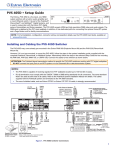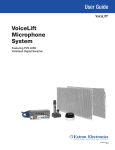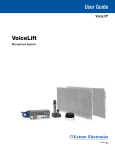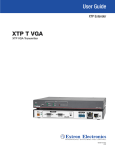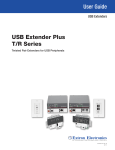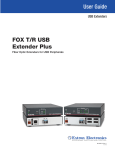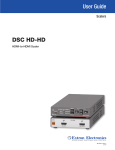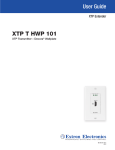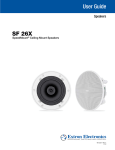Download Extron electronics PVS 405D Installation guide
Transcript
Installation Guide VoiceLift VoiceLift Microphone System Featuring PVS 405D PoleVault Digital Switcher 68-2548-20 Rev. A 02 14 Safety Instructions Safety Instructions • English WARNING: This symbol, , when used on the product, is intended to alert the user of the presence of uninsulated dangerous voltage within the product’s enclosure that may present a risk of electric shock. ATTENTION: This symbol, , when used on the product, is intended to alert the user of important operating and maintenance (servicing) instructions in the literature provided with the equipment. For information on safety guidelines, regulatory compliances, EMI/EMF compatibility, accessibility, and related topics, see the Extron Safety and Regulatory Compliance Guide, part number 68-290-01, on the Extron website, www.extron.com. Instructions de sécurité • Français AVERTISSEMENT : Ce pictogramme, , lorsqu’il est utilisé sur le produit, signale à l’utilisateur la présence à l’intérieur du boîtier du produit d’une tension électrique dangereuse susceptible de provoquer un choc électrique. ATTENTION :Ce pictogramme, , lorsqu’il est utilisé sur le produit, signale à l’utilisateur des instructions d’utilisation ou de maintenance importantes qui se trouvent dans la documentation fournie avec le matériel. Pour en savoir plus sur les règles de sécurité, la conformité à la réglementation, la compatibilité EMI/EMF, l’accessibilité, et autres sujets connexes, lisez les informations de sécurité et de conformité Extron, réf. 68-290-01, sur le site Extron, www.extron.com. Sicherheitsanweisungen • Deutsch WARNUNG: Dieses Symbol auf dem Produkt soll den Benutzer darauf aufmerksam machen, dass im Inneren des Gehäuses dieses Produktes gefährliche Spannungen herrschen, die nicht isoliert sind und die einen elektrischen Schlag verursachen können. VORSICHT: Dieses Symbol auf dem Produkt soll dem Benutzer in der im Lieferumfang enthaltenen Dokumentation besonders wichtige Hinweise zur Bedienung und Wartung (Instandhaltung) geben. Weitere Informationen über die Sicherheitsrichtlinien, Produkthandhabung, EMI/EMF-Kompatibilität, Zugänglichkeit und verwandte Themen finden Sie in den Extron-Richtlinien für Sicherheit und Handhabung (Artikelnummer 68-290-01) auf der Extron-Website, www.extron.com. Instrucciones de seguridad • Español ADVERTENCIA: Este símbolo, , cuando se utiliza en el producto, avisa al usuario de la presencia de voltaje peligroso sin aislar dentro del producto, lo que puede representar un riesgo de descarga eléctrica. ATENCIÓN: Este símbolo, , cuando se utiliza en el producto, avisa al usuario de la presencia de importantes instrucciones de uso y mantenimiento recogidas en la documentación proporcionada con el equipo. Para obtener información sobre directrices de seguridad, cumplimiento de normativas, compatibilidad electromagnética, accesibilidad y temas relacionados, consulte la Guía de cumplimiento de normativas y seguridad de Extron, referencia 68-290-01, en el sitio Web de Extron, www.extron.com. Инструкция по технике безопасности • Русский ПРЕДУПРЕЖДЕНИЕ: Данный символ, , если указан на продукте, предупреждает пользователя о наличии неизолированного опасного напряжения внутри корпуса продукта, которое может привести к поражению электрическим током. ВНИМАНИЕ: Данный символ, , если указан на продукте, предупреждает пользователя о наличии важных инструкций по эксплуатации и обслуживанию в руководстве, прилагаемом к данному оборудованию. Для получения информации о правилах техники безопасности, соблюдении нормативных требований, электромагнитной совместимости (ЭМП/ЭДС), возможности доступа и других вопросах см. руководство по безопасности и соблюдению нормативных требований Extron на сайте Extron: www.extron.com, номер по каталогу - 68-290-01. Chinese Simplified(简体中文) 警告: 产品上的这个标志意在警告用户该产品机壳内有暴露的危险 电压, 有触电危险。 注 意: 产 品 上 的 这个 标 志 意 在 提 示用 户 设 备 随 附 的 用 户 手 册 中 有 重要的操作和维护(维修)说明。 关于我们产品的安全指南、遵循的规范、EMI/EMF 的兼容性、无障碍 使用的特性等相关内容,敬请访问 Extron 网站 www.extron.com,参见 Extron 安全规范指南,产品编号 68-290-01。 Chinese Traditional( ) 警告: 若產品上使用此符號,是為了提醒使用者,產品機殼內存在著 可能會導致觸電之風險的未絕緣危險電壓。 注意 若產品上使用此符號,是為了提醒使用者,設備隨附的用戶手冊中有重 要的操作和維護(維修)説明。 有關安全性指導方針、法規遵守、EMI/EMF 相容性、存取範圍和相關主題的詳細資 訊,請瀏覽 Extron 網站:www.extron.com,然後參閱《Extron 安全性與法規 遵守手冊》,準則編號 68-290-01。 Japanese 警告: この記号 が製品上に表示されている場合は、筐体内に絶縁されて いない高電圧が流れ、感電の危険があることを示しています。 注意: この記号 が製品上に表示されている場合は、本機の取扱説明書 に 記載されている重要な操作と保守(整備)の指示についてユーザーの 注 意を喚起するものです。 安全上のご注意、法規厳守、EMI/EMF適合性、その他の関連項目に ついては、エクストロンのウェブサイト www.extron.com より『Extron Safety and Regulatory Compliance Guide』(P/N 68-290-01) をご覧ください。 Korean 경고: 이 기호 가 제품에 사용될 경우, 제품의 인클로저 내에 있는 접지되지 않은 위험한 전류로 인해 사용자가 감전될 위험이 있음을 경고합니다. 주의: 이 기호 가 제품에 사용될 경우, 장비와 함께 제공된 책자에 나와 있는 주요 운영 및 유지보수(정비) 지침을 경고합니다. 안전 가이드라인, 규제 준수, EMI/EMF 호환성, 접근성, 그리고 관련 항목에 대한 자세한 내용은 Extron 웹 사이트(www.extron.com)의 Extron 안전 및 규제 준수 안내서, 68-290-01 조항을 참조하십시오. FCC Class A Notice This equipment has been tested and found to comply with the limits for a Class A digital device, pursuant to part 15 of the FCC rules. The Class A limits provide reasonable protection against harmful interference when the equipment is operated in a commercial environment. This equipment generates, uses, and can radiate radio frequency energy and, if not installed and used in accordance with the instruction manual, may cause harmful interference to radio communications. Operation of this equipment in a residential area is likely to cause interference. This interference must be corrected at the expense of the user. NOTE: For more information on safety guidelines, regulatory compliances, EMI/EMF compatibility, accessibility, and related topics, see the “Extron Safety and Regulatory Compliance Guide” on the Extron website. Copyright © 2014 Extron Electronics. All rights reserved. Trademarks All trademarks mentioned in this guide are the properties of their respective owners. The following registered trademarks, registered service marks, and trademarks are the property of RGB Systems, Inc., or Extron Electronics: Registered Trademarks (®) AVTrac, Cable Cubby, CrossPoint, eBUS, EDID Manager, EDID Minder, Extron, Flat Field, GlobalViewer, Hideaway, Inline, IP Intercom, IP Link, Key Minder, LockIt, MediaLink, PlenumVault, PoleVault, PowerCage, PURE3, Quantum, SoundField, SpeedMount, SpeedSwitch, System INTEGRATOR, TeamWork, TouchLink, V‑Lock, VersaTools, VN‑Matrix, VoiceLift, WallVault, WindoWall, XTP, and XTP Systems Registered Service Mark(SM) : S3 Service Support Solutions Trademarks (™) AAP, AFL (Accu‑Rate Frame Lock), ADSP (Advanced Digital Sync Processing), AIS (Advanced Instruction Set), Auto‑Image, CDRS (Class D Ripple Suppression), DDSP (Digital Display Sync Processing), DMI (Dynamic Motion Interpolation), Driver Configurator, DSP Configurator, DSVP (Digital Sync Validation Processing), FastBite, FOXBOX, IP Intercom HelpDesk, MAAP, MicroDigital, ProDSP, QS-FPC (QuickSwitch Front Panel Controller), Scope‑Trigger, SIS, Simple Instruction Set, Skew‑Free, SpeedNav, Triple‑Action Switching, XTRA, ZipCaddy, ZipClip Conventions Used in this Guide Notifications The following notifications are used in this guide: CAUTION: A caution indicates a situation that may result in minor injury. ATTENTION: Attention indicates a situation that may damage or destroy the product or associated equipment. NOTE: A note draws attention to important information. Software Commands Commands are written in the fonts shown here: ^AR Merge Scene,,Op1 scene 1,1 ^B 51 ^W^C [01] R 0004 00300 00400 00800 00600 [02] 35 [17] [03] E X! *X1&* X2)* X2#* X2! CE} NOTE: For commands and examples of computer or device responses mentioned in this guide, the character “0” is used for the number zero and “O” is the capital letter “o.” Computer responses and directory paths that do not have variables are written in the font shown here: Reply from 208.132.180.48: bytes=32 times=2ms TTL=32 C:\Program Files\Extron Variables are written in slanted form as shown here: ping xxx.xxx.xxx.xxx —t SOH R Data STX Command ETB ETX Selectable items, such as menu names, menu options, buttons, tabs, and field names are written in the font shown here: From the File menu, select New. Click the OK button. Specifications Availability Product specifications are available on the Extron website, www.extron.com. Contents Introduction........................................................... 1 Stage 2: Mounting the FF 20 Speakers..... 22 About this Guide................................................ 1 About the VoiceLift System................................ 1 Application Diagram........................................... 2 Planning the Installation..................................... 3 Receiver Coverage......................................... 3 Room Considerations..................................... 4 Receiver Location........................................... 7 PoleVault Switcher Location........................... 8 Inventory............................................................. 9 Installation Tools........................................... 11 Items Not Included....................................... 12 Optional Items.............................................. 12 FF 120 Flat Field Ceiling Speakers................... 22 Speaker Cable.................................................. 22 Speaker Mounting Procedure.......................... 23 Installation Overview........................................ 13 Stage 1 — Install the VLR 102 Receiver.......... 13 Stage 2 — Install the FF 120 Speakers (VLS Only)........................................................ 13 Stage 3 — Install the PVS 405D Switcher (VLS Only)........................................................ 13 Stage 4 — Connect the VLR 102 Receiver to the PoleVault System.................................. 14 Stage 5 — Configure and Test the System...... 14 Installation Procedures..................................... 14 Stage 3: Installing the PoleVault Switcher................................................................ 26 PVS 405D PoleVault Switcher.......................... 26 PoleVault Switcher Installation......................... 27 Stage 4: Connecting the Cables................... 28 Receiver Dome................................................. 28 STP Cable........................................................ 28 Procedure......................................................... 29 Stage 5: Testing the System.......................... 33 Installation Example — Setting Up an Instant Alert......................................................... 37 Stage 1: Mounting the Receiver................... 15 Receiver Housing and Back Plate.................... 15 Z-bracket and Mounting Screw (for Installation in a Drop Ceiling)........................... 15 Stage 1a — Installing the Receiver in a Drop Ceiling..................................................... 17 Stage 1b — Installing the Receiver to a Junction Box................................................... 18 Stage 1c — Installing the Receiver on a Wall or Other Hard Surface............................. 19 Stage 1d — Installing the Receiver on a Pole................................................................. 21 VoiceLift System with PVS 405D Installation Guide • Contents v vi VoiceLift System with PVS 405D Installation Guide • Contents Introduction This section provides an overview of the VoiceLift System and gives instructions for planning the installation and preparing the site in which the system will operate. It also provides a listing of the available system kits and their contents. Topics include: • About this Guide • About the VoiceLift System • Application Diagram • Planning the Installation • Inventory About this Guide This guide provides steps to install and connect each component of the Extron VoiceLift System. The VoiceLift VLR 102 receiver can be installed in a drop ceiling, a standard junction box, an octagonal ceiling box, or a wall. It is assumed that the installer has some knowledge of and experience with audio/video, electrical, or electronic device installation. ATTENTION: • Installation and service must be performed by authorized personnel only. • UL listed electrical boxes are recommended. About the VoiceLift System The VoiceLift System is a low-power classroom microphone amplification system that ensures that an instructor can be clearly heard at a comfortable level throughout the entire room (also referred to as a “soundfield system”). The pendant or hand-held microphone picks up speech from the instructor or student and transmits it to the receiver via an IR signal. From the receiver, the signal is sent to an Extron PoleVault switcher, which amplifies and powers speakers to improve the signal-to-noise ratio to at least +15 dB. Two types of VoiceLift system are available: • VLM System — Consists of one or two pendant microphones or one pendant and one handheld microphone, the IR receiver, and an optional charging station (this kit can be added to an existing PoleVault system). • VLS System — Consists of the VLM System kit components, a PoleVault switcher, and two speakers. See Inventory beginning on page 9 for more information on kit contents. Each VoiceLift system contains a feedback suppressor (FBS) that eliminates feedback caused by high microphone levels, room resonance, or proximity of the microphone to the speakers. If feedback occurs, up to 15 dynamic filters engage, automatically detecting and attenuating unwanted feedback frequencies up to 30 dB. VoiceLift System with PVS 405D Installation Guide • Introduction 1 Application Diagram The application diagram below shows a typical classroom installation incorporating the VoiceLift System. VLP 202 Pendant Microphone Tx S G W P R EGRAHC E r tx no NO /FFO GHC/ETUM IN AUDIO ER Extron FF 120 IN COMPUT IN AUDIO R IN VIDEO 2 AUX VIDEO OFF 3 ON PC 4 CONFIG IMAGE MUTE 104 TCP/IP Network IP Plus MLC Extr on VLC 202 Desktop Charging Station Figure 1. 2 VLR 102 Receiver Plenum Flat ® Field Speakers L 1 VIDEO DISPLAY VOLUME Typical Classroom Installation VoiceLift System with PVS 405D Installation Guide • Introduction PVS 405D Twisted Pair Switcher Planning the Installation Before you begin the installation, consider the major factors discussed in the following sections to ensure that the installation of the VoiceLift System is as smooth and trouble free as possible and that the result meets the needs of the users. Placement of the receiver (sensor location) is very important for optimal performance of the VoiceLift System. Because IR technology requires line-of-sight placement, take into consideration anything that could affect or block the transmission of the IR signal from the microphone to the receiver (see Room Considerations on the next page). 5 ft. (1.5 m) to 40 ft. (10.2 m) In Out INPUTS OUTPUT AUDIO OUT L 1/2 POWER 12V 3A MAX SIG 3/4 LINK VLR 102 Receiver Figure 2. SIG LINK PAGING SENSOR +V INPUT 5 L PVT IN R HDMI PVS 405D AMPLIFIED AUDIO OUT DO NOT GROUND OR SHORT 4/8 SPEAKER Ω OUTPUTS VOICELIFT AUX OVER PVT R PVT IN L R LAN 1 LAN 2 LAN 3 REMOTE IR RS-232 S G Tx Rx G VoiceLift Connections and Signal Path Receiver Coverage The VoiceLift receiver has the same room coverage pattern whether it is mounted on the ceiling or a wall. VoiceLift Receiver Ceiling or Wall VoiceLift Microphone Figure 3. VoiceLift Receiver Coverage NOTE: Coverage is dependent mainly on the room environment, but also on the microphone. You can attain maximum coverage when the batteries are fully charged. Reception may decrease as the battery drains. VoiceLift System with PVS 405D Installation Guide • Introduction 3 Room Considerations The following room factors are important to consider when you are planning the installation of a VoiceLift system: Interference and noise sources Infrared and radio frequency noise can reduce the performance of the microphone system. To minimize noise in the system, avoid mounting the VoiceLift receiver near the following items: • Lighting, fluorescent or incandescent — Keep the receiver at least 2 feet (61 centimeters) away from a light source. Do not place the receiver where light can shine directly into it. • Sunlight — Place the receiver at least 6 feet (1.8 meters) away from windows and skylights. If this is not possible, cover windows and skylights with curtains, blinds, or other covering options. • Plasma displays — Do not have plasma displays in the room with the microphone system. • Electrical equipment — Take placement of electrical equipment such as power lines or supplies, projectors, dimmers, and computers into consideration, as these could interfere with the IR signal. • Cellular phones — Keep cell phones at least 2 feet (61 centimeters) away from both the receiver and the microphone. • Other IR devices — Take placement of other IR devices such as assistive listening devices or IR remote controls into consideration, as these could interfere with the IR signal. IR Transmitter Window 6 Ft. 2 Ft. Plasma VLR 102 Receiver Gr adua tio n 200 9 Ana heim Chi Fam ldre ily n’s YM Stat CA ion PWR CHARGE OFF/MUTE/CHG ON Extron Extron 4 Jay Cla ss of Ceiling Lighting Figure 4. Blue Potential Causes of Noise Interference VoiceLift System with PVS 405D Installation Guide • Introduction Line-of-sight obstructions between microphone and receiver A clear line of sight between the microphone and the receiver is critical for best performance. Take the following potential obstructions to the IR signal into consideration when placing the receiver: • Movable furniture (such as desks, tables, and podiums) • Installed furniture (such as bookcases, racks, cabinets, workbenches, and sinks) • Support pillars • I-beams • Projectors Ceiling Beams VLR 102 Receiver Blu e Jay Gr Cla ss of adua tio n 200 9 Ana heim Chil Fam dren ily ’s StatYMC ion A OFF/MUTE/CHG ON CHARGE PWR Extron Extron Extron Figure 5. Not Good Potential Line-of-Sight Obstructions VoiceLift System with PVS 405D Installation Guide • Introduction 5 Reflection Line of sight from the microphone to the receiver is ideal; however, reflection of the IR signal also plays a part in the coverage for most rooms. For example, if the speaker with the microphone is facing a screen, the IR signal may reflect off the screen surface to the receiver in the middle of the room. Ideal conditions for reflection are light colored, smooth surfaces (for example, white drywall). Items to consider that may affect reflection include: • Ceiling type (such as drop, spline, or hard lid) • Wall type (such as drywall, cement, acoustical panel, or brick) • Wall coverings (such as wall art, hangings, or dark colored paint) • Curtains and blinds • Furniture (such as bookcases or easels) VLR 102 Receiver Blu e Jay Gr Cla ss of adua tio n 200 9 no rtx E Ana heim Chil Fam dren ily ’s StatYMC ion A Good Extron CHARGE PWR Not Good OFF/MUTE/CHG ON Extron Extron Figure 6. 6 Reflective Surfaces VoiceLift System with PVS 405D Installation Guide • Introduction Receiver Location The best location to mount the receiver is on the ceiling in the center of the classroom. If the receiver is wall-mounted, center it on the wall between 6 feet (1.8 meters) and 12 feet (3.6 meters) from the floor. These locations maximize the coverage and line of sight to the microphone. Avoid the corners of the room, alcoves, bays, or sheltered areas that can restrict coverage. If the ceiling is over 12 feet (3.6 meters) high, consider mounting the receiver on a pole to reduce the line-of-sight distance to the microphone. PoleVault A-V Wallplate Location Screen or White Board Location Potential VLR 102 IR Receiver Locations Instructor Desk TV / VCR / DVD Inputs MLC Controller Location Ceiling Mount Wall Mount Projector and Switcher Location Speaker Locations Student Desks Figure 7. Diagram of a Classroom Installation VoiceLift System with PVS 405D Installation Guide • Introduction 7 PoleVault Switcher Location The PoleVault switcher can be mounted anywhere in the room, because the volume controls are on the microphone. However, placing the switcher near the ceiling makes cabling and upgrading to a full PoleVault system easier. WARNING: Structural ceiling failure could cause serious injury or death. Check the structural ceiling to ensure that it can handle a load four times the weight of the final setup. R CON FIG PVS 405D SEL EC INP T UT S 1 2 3 4 AU DIO 5 AU X Digital PoleVault Switcher INP UT AU PEA K NO RM SIG AL NA L DIO LEV EL VO ICE AD JU ST LIF T PEA NO K RM SIG AL NA L PA GIN SE NS G OR SE NS ITIV PV POL S 40 EVA ULT 5S A IP SWI TCH ER ITY PMK 550 Projector Mount Kit Figure 8. Mounting a PoleVault Switcher to a Projector Pole Possible switcher mounting locations include: 8 • On a desk • Mounted to a wall • Under a desk • Mounted to a ceiling pole • In a cabinet • Above a drop ceiling (The PVS is plenum rated.) VoiceLift System with PVS 405D Installation Guide • Introduction Inventory The VoiceLift VLS System kit is available in three packaged configurations: • VLS 1000D: Contains one VLP 102 Pendant Microphone, a VLR 102 Receiver, a wall charger, and two FF 120 Flat Field speakers. • VLS 2000D: Contains two VLP 102 Pendant Microphones, a VLR 102 Receiver, a wall charger, a VLC 102 Charging Station, and two FF 120 speakers. • VLS 2000DH: Contains one VLP 102 Pendant Microphone, one VLH 102 Handheld Microphone, a VLR 102 Receiver, a wall charger, a VLC 202 Charging Station, and two FF 120 speakers. VoiceLift VLS 1000D or VLS 2000 System 42-239-01 or 42-239-02 FF 120 42-120-03 PVS 305SA INPUT SELECTION POLEVAULT SWITCHER 1 2 3 4 AUDIO LEVEL ADJUST 5 INPUT CONFIG PEAK MIC PEAK NORMAL NORMAL SIGNAL SIGNAL AUX AUDIO VOICELIFT PAGING SENSOR SENSITIVITY PVS 305SA PoleVault Switcher VLR 102 IR Receiver VLP 202 Pendant Microphone (1 or 2) (2) FF 120 Speakers 50 feet (15.2 m) STP Cable (1) 2-pole Captive Screw Connector (3) 3-pole Captive Screw Connector (2) 5-pole Captive Screw Connector (1) Audio Connector, 4-pole (4) Tie Wraps (4) Rubber Feet (2) Cable Clamps – Anchor Ring (2) T-rails Wall Charger/ Power Supply VLC 202 Charging Station (VLS 2000 only) Lanyard and Lanyard Clip (1 or 2) AA Rechargeable Battery (1 or 2) (1) Power Supply (1) Power Cord Z Bracket and Screw Teacher one t™ Microph VoiceLif n stallatio User In Card 100 feet (30.4 m) Speaker Cable VoiceLift User Installation Card Mic 1 Student Mic 2 Microphone Label Set VoiceLift System with PVS 405D Installation Guide • Introduction 9 FF 120 42-120-03 VoiceLift VLS 2000DH System 42-239-22 INPUTS OUTPUT AUDIO OUT L 1/2 POWER 12V 3A MAX SIG 3/4 LINK SIG PAGING SENSOR +V INPUT 5 L PVT IN R HDMI LINK PVS 405D AMPLIFIED AUDIO OUT DO NOT GROUND OR SHORT 4/8 SPEAKER Ω OUTPUTS VOICELIFT AUX OVER PVT R PVT IN L R LAN 1 LAN 2 LAN 3 REMOTE IR RS-232 S G Tx Rx G PVS 405D PoleVault Switcher VLR 102 IR Receiver (2) FF 120 Speakers (1) VLP 202 Pendant Microphone and (1) VLH 102 Handheld Microphone (1) 2-pole Captive Screw Connector (3) 3-pole Captive Screw Connector (2) 5-pole Captive Screw Connector (1) Audio Connector, 4-pole (4) Tie Wraps (4) Rubber Feet Lanyard and Lanyard Clip (2) Cable Clamps – Anchor Ring (2) T-rails VLC 202 Charging Station Wall Charger/ Power Supply (1) Power Supply (1) Power Cord (2) AA Rechargeable Batteries Z Bracket and Screw ophone t™ Micr VoiceLif n stallatio User In Card 100 Feet (30.4 m) Speaker Cable 50 Feet (15.2 m) STP Cable Teacher Mic 1 Student Mic 2 VoiceLift User Installation Card Microphone Label Set NOTE: If any items in the VoiceLift System or FF 120 boxes are damaged or missing, contact the Extron S3 Sales and Technical Support Hotline (see the rear cover for contact numbers). 10 VoiceLift System with PVS 405D Installation Guide • Introduction Installation Tools Extron recommends the following equipment (not provided) to ensure that the VoiceLift System is properly installed. Safety Goggles Marker Pen, Pencil Handsaw for Cutting Drywall Utility Knives Tools for Terminating Cable RJ-45 Crimpers and Connectors Flashlight Tape Measure Power Drill Cable Cutters 3/4-inch Extension Bit for Drilling Through Fire Breaks Screw Driver Set Stud Finder Zip Ties Fish Tape Vacuum Cleaner VoiceLift System with PVS 405D • Introduction 11 Items Not Included The following items are not included. However, some or all of them may be needed for the installation at your particular site. • Additional length of RJ-45 cabling (CAT 5, 5e, or 6 with T568A or T568B straight-through cabling) • Installation hardware (may vary by installation): • Electrical ceiling box • Junction box • Plaster ring • Raceway • Bolts for concrete structural ceilings where needed • Dry wall anchors and screws • Spare ceiling tiles in case of accidental damage during installation • Safety wire, lag eye bolts, and strain reliefs • Heat shrink • Extension cord Optional Items The optional items listed below can be added to or substituted for items in the standard VoiceLift System kits. 12 • VLP 202 Pendant Microphone (additional) or VLH 102 Handheld Microphone • PVS 405D mounting options • WMK 160 WallVault wall mounting kit • PMK 560 pole mounting kit VoiceLift System with PVS 405D Installation Guide • Introduction Installation Overview This section provides an overview of the five stages of installation for the VoiceLift system and the steps required for each stage. Stage 1 — Install the VLR 102 Receiver Choose one of these installation types: 1a. Drop ceiling c Cut a hole in the ceiling tile (page 17). c Mount the receiver housing to the ceiling tile (page 17). c(Optional) Attach a conduit to the back plate if needed (page 17). 1b. Junction box c Install the junction box (page 18). c Attach the receiver housing to the junction box (page 18). c Attach a conduit to the junction box if needed (page 18). 1c. Wall or other hard surface c Install a raceway if needed (page 19). c Mark the mounting screw hole locations on the surface (page 19). c If using a raceway, remove the appropriate knockout in the receiver housing (page 19). c Mount the receiver housing to the surface (page 20). 1d. Pole c Attach the pole to the ceiling (page 21). c Mount the receiver housing to the pole (page 21). Stage 2 — Install the FF 120 Speakers (VLS Only) c Cut the ceiling tile (page 23). c Install the speakers in the drop ceiling (page 23). c (Optional) Install a seismic safety cable at each speaker location (page 24). c Terminate the speaker cable for the PVS switcher (page 24). Stage 3 — Install the PVS 405D Switcher (VLS Only) c Install the PoleVault switcher (page 26). See the PoleVault Systems Featuring the PVS 405D Switcher Installation Guide for the procedures. VoiceLift System with PVS 405D Installation Guide • Installation — Overview 13 Stage 4 — Connect the VLR 102 Receiver to the PoleVault System c Pull the cables to the receiver (page 29). c Connect the cables to the receiver (page 29). c Attach the receiver dome to the housing (page 30). c Pull the cables to the PoleVault switcher (page 31). c Connect the cables to the PoleVault switcher (page 32). Stage 5 — Configure and Test the System c Set up the microphones (page 33). c Set the microphone gain and feedback suppressor (FBS) (page 34). c Complete the installation (page 36). Installation Procedures The following sections contain instructions for installing the VoiceLift System. Where possible, line drawings and photos from an actual installation are used to clarify some of the steps discussed in the text. Each image has a circled number corresponding to the step that is being described (for example, Å). NOTES: • Additional installation hardware is needed for this installation and should be supplied by the installer (see Items Not Included on page 14 for a list of items that you may need). • Consider optional accessories for this installation (see Optional Items on page 12 for a list of available accessories, or visit www.extron.com for details). • See local building standards and codes to verify that the installation will meet all the regulatory requirements. Observe all local and national building and safety codes, UL requirements, and ADA Accessibility Guidelines. • Before beginning the installation, be sure to check the contents of your VoiceLift packages against the appropriate inventory list, beginning on page 9, to ensure that you have received all of the necessary components. 14 VoiceLift System with PVS 405D Installation Guide • Installation — Overview Stage 1: Mounting the Receiver This stage consists of installing the VLR 102 receiver in a drop ceiling or on a wall. Receiver Housing and Back Plate Back Plate Conduit Knockouts (2) Raceway Knockouts (2) Receiver Housing Figure 9. Receiver Housing and Back Plate Where it goes: The housing attaches to the receiver dome, and the back plate mounts to a ceiling tile or a wall. What it does: Protects the receiver base plate and connectors. The housing contains knockouts for different sizes of raceways, and the back plate contains knockouts for a conduit. Z-bracket and Mounting Screw (for Installation in a Drop Ceiling) Z-bracket Mounting Screw Figure 10. Z-bracket and Mounting Screw Where it goes: The mounting screw passes through the receiver back plate, then through the hole in the ceiling tile. The bracket is attached to the screw on the back of the ceiling tile. What it does: Fastens the receiver to a tile in a drop ceiling. VoiceLift System with PVS 405D Installation Guide • Installation — Stage 1 15 Stage 1a: Installing the VoiceLift Receiver in a Drop Ceiling (page 17) Stage 1b: Installing the VoiceLift Receiver to a Junction Box (page 18) Stage 1c: Installing the VoiceLift Receiver to a Wall (page 19) Stage 1d: Installing the VoiceLift Receiver on a Pole (page 21) Figure 11. Diagrams of Stage 1 Mounting Options NOTE: Observe all local and national building and safety codes to ensure that the installation meets all regulatory standards. 16 VoiceLift System with PVS 405D Installation Guide • Installation — Stage 1 Stage 1a — Installing the Receiver in a Drop Ceiling 1. Cut a hole in the ceiling tile. a. Remove the ceiling tile in which the receiver will be installed. b. Determine the receiver location, then cut a hole in the ceiling tile 2 to 3.5 inches (5 to 9 cm) in diameter, using a circular (shown at right) or other type of saw (saws are not included). NOTE: This hole should be large enough to expose the conduit knockout and the hole for the mounting screw in the receiver back plate, but it should not exceed the diameter of the receiver housing (4.75 inches [12.1 cm]). ÅCut a hole in the ceiling tile. 2. Mount the receiver housing to the ceiling tile. a. Insert the ceiling bracket screw through the back plate (attached to the housing) and the hole in the ceiling tile. b. Attach the Z-bracket loosely to the screw on the back side of the ceiling tile. c. Align the back plate knockout over the hole in the tile. d. Tighten the screw to secure the back plate and the housing to the tile. ïSecure the receiver back plate to the ceiling tile and the Z-bracket. 3. (Optional) Attach a conduit to the back plate if needed (see figure c). NOTE: Observe all local and national building and safety codes. 4. Replace the ceiling tile. c Attach a conduit to the back plate if desired. VoiceLift System with PVS 405D Installation Guide • Installation — Stage 1 17 Stage 1b — Installing the Receiver to a Junction Box 1. Install the junction box. • Install the junction or ceiling box (not included) flush with the mounting surface (follow the instructions provided with the junction box). • Use a one-gang plaster ring (Raco 772) if the junction box is larger than one‑gang. WARNING: Risk of electric shock. Improper installation may result in electrical shock or serious injury. All electrical installation should be performed by qualified personnel in accordance with local and national building codes, fire and safety codes, and local and national electrical codes. aAttach the junction box flush with the mounting surface. 2. Attach the receiver housing to the junction box. Mounting Screws a. Align the receiver housing with the junction box. b. Secure the housing in place with the appropriate screws (not included). Junction Box Mounting Holes (2) Plaster Ring Ceiling Box Mounting Holes (2) ÉAttach the receiver housing to the junction box. 3. Attach a conduit to the junction box if needed. NOTE: Observe all local and national building and safety codes. c Attach a conduit to the junction box if needed. 18 VoiceLift System with PVS 405D Installation Guide • Installation — Stage 1 Stage 1c — Installing the Receiver on a Wall or Other Hard Surface 1. Install a raceway if needed. If using a raceway for the cables, install it at the appropriate location on the mounting surface. NOTE: Raceway knockouts on the receiver housing fit common types of raceways such as the Wiremold 500/700 series and the Wiremold 2400 series. Follow the instructions provided by the manufacturer to install the raceway. a Install the raceway (if needed). 2. Mark the mounting screw locations on the surface. Use the screw holes in the receiver housing as guides to mark the screw locations on the mounting surface. b Mark mounting screw locations in the surface. 3. If using a raceway, remove the appropriate knockout in the receiver housing. Raceway Knockouts (2) a. Use a knife to score around the edge of the selected raceway knockout to create a clean edge. b. Press on the scored section to remove it. c Remove a raceway knockout from the housing, if needed. VoiceLift System with PVS 405D Installation Guide • Installation — Stage 1 19 4. Mount the receiver housing to the surface. If not using a raceway: Mount the receiver housing and base to the surface, using the appropriate screws for the type of surface. NOTE: Screws and wall anchors are not included. dMounting without a raceway If using a raceway: Position the receiver housing with the raceway inserted through the knockout. d Mounting with a raceway 20 VoiceLift System with PVS 405D Installation Guide • Installation — Stage 1 Stage 1d — Installing the Receiver on a Pole 1. Attach the pole to the ceiling. Attach the required length of ¾-inch (19 mm) diameter electrical metal tubing (EMT) or downrod to the ceiling. NOTE: You can use ½-inch tubing for the pole. However, the RJ-45 connector on the twisted pair communication cable does not fit through this size pole. To use tubing this size, you must remove the connector from the cable, pull the cable through the pole, then reterminate the cable. Example: If desired, you can attach the pole to a junction box as shown at right. a Attach the pole to the ceiling (junction box is optional). 2. Mount the receiver housing to the pole. a. Remove a large knockout from the receiver back plate to accommodate the ¾-inch (19 mm) pole (see figure Ç). b. Attach a ¾-inch (19 mm) clamp, compression, or set screw connector to the other end of the pole (see figure É). c. Remove the lock nut from the connector and insert the connector into the large knockout space on the metal back plate. Ç Remove the large knockout (outer ring). É Attach a ¾-inch connector to the pole. d. Replace the lock nut onto the connector and tighten it to secure the connector to the housing. î – ï Attach the pole to the receiver back plate. VoiceLift System with PVS 405D Installation Guide • Installation — Stage 1 21 Stage 2: Mounting the FF 20 Speakers This stage consists of installing and connecting the FF 120 speakers (VLS only). NOTE: The installation must conform to national and local electrical codes and UL requirements (see the FF 120 Flat Field Speakers User Guide for details). FF 120 Flat Field Ceiling Speakers FF 120 Speakers (2) Terminal Cover Cable Clamps (2) Seismic Tabs (3 per side) Anchor Rings (2) T-rails (2) Figure 12. FF 120 Ceiling Speaker Where they go: Installed in ceiling tiles at a location selected for best acoustics What they do: Receive and output the audio signal from the PVS 405D switcher. Speaker Cable SPK 18, 35 feet (10.6 m) Figure 13. SPK 18 Speaker Cable What it does: For speaker installation, connects the ceiling speakers to the switcher. 22 VoiceLift System with PVS 405D Installation Guide • Installation — Stage 2 Speaker Mounting Procedure 1. Cut the ceiling tile. See the FF 120 Flat Field Speaker User Guide, available at www.extron.com, for detailed instructions. a. Remove the ceiling tiles where the speakers will be installed. TIP: For ease of working on the speaker when it is replaced on the T-frame, remove the adjacent tiles. Å Mark a line on the ceiling tile. b. Mark a line 12 inches (30 cm) from and parallel to one of the short edges of the tile. c. Cut along the line and discard the short part. TIP: Use a fine hacksaw blade to cut the tile without damaging the face, and place an empty box under the tile for support and to collect the waste. û Cut the ceiling tile on the marked line. 2. Install the speakers in the drop ceiling. a. At the speaker location, lay one of the supplied T-rails 12 inches (30 cm) from one end of the T-frame. The speaker will be placed into the small section. b. Remove the terminal cover from the rear of a speaker and attach the anchor ring and cable clamp to the cover. c. Place the speaker onto the T-frame and pass the speaker cable through the cable clamp. d. Connect the speaker wires to the speaker terminals: Ç Place the T-rails on the T-frame. • Red wire: positive (+) • Black wire: negative (–) ATTENTION: Do not short the speaker wires together because this could cause damage to the speakers. e. Reattach the terminal cover and, if possible, bend the seismic tabs down over the T-rails. f. Replace the ceiling tile. g. Repeat steps 2a through 2f for each speaker that needs to be installed. É Remove the terminal cover and attach the clamp and ring to it. VoiceLift System with PVS 405D Installation Guide • Installation — Stage 2 23 3. (Optional) Install a seismic safety cable at each speaker location. a. Mark, drill, and install a lag eye bolt for the seismic safety cables (not included) in the ceiling above the speaker location. Cable Clamp Adapter Top Terminal Cover Seismic Anchor Ring b. Pass the seismic cable through the anchor ring down to the nearest seismic tab and twist the end around the cable five times. Anchor this end to a lag eye bolt screwed into the structural ceiling. Route the safety cable through the anchor ring and the seismic tab. Locking Ring c. Pass the other end of the cable up through the lag eye bolt (see step 3a) and twist that end around the cable five times. Seismic Safety Cable Ö- ñ Attach the seismic safety cable. 4. Terminate the speaker cable for the PVS switcher. To terminate the cable, strip the end of the cable 0.2 inch (5 mm) and secure the wires into the supplied 4-pole captive screw connector. Speaker 1 Speaker 2 4-pole Captive Screw Connector NOTE: The correct speaker impedance loading must be observed when you are setting up a speaker system (see figure 14 on the next page for examples). Audio Output to Speakers 4-pole Captive Screw Connector AMPLIFIED OUTPUTS 4/8 Ohms L R PVS Switcher Rear Panel Speaker Wire Color To PVS 405D Terminal (Left and Right) Red Positive (+) Black Negative (-) d Wire the captive screw connector. 24 VoiceLift System with PVS 405D Installation Guide • Installation — Stage 2 FIG_Speaker Wiring Examples AMPLIFIED OUTPUTS AMPLIFIED OUTPUTS 8 Ohms Mono + 8 Ohms Mono + L Stereo L+ R Stereo R+ L Mono – Mono – R Stereo L– 8 Ohm Load Stereo R– 8 Ohm Load Stereo Output Dual Mono Output AMPLIFIED OUTPUTS 4/8 Ohms Mono + or Stereo L+ 8 ohms 8 ohms 8 ohms 4 Ohm Total Load Mono – or Stereo L- Two 8 ohm speakers wired in parallel equal a 4 ohm load. Mono + or Stereo R+ L R Mono – or Stereo R- 8 ohms 4 Ohm Total Load Stereo or Dual Mono Output Using Parallel Speaker Wiring Figure 14. Speaker Wiring Examples NOTE: By default, the switcher/amplifier is set for dual mono output. Use the Universal Switcher Control software or the Extron Special Instruction Set (SIS™) commands to change the setting to stereo if desired. For full details, see the PoleVault Systems Featuring the PVS 405D Switcher Installation Guide, available at www.extron.com. VoiceLift System with PVS 405D Installation Guide • Installation — Stage 2 25 Stage 3: Installing the PoleVault Switcher This stage consists of installing the PVS 405D PoleVault Switcher (VLS only). See the PoleVault Systems Featuring the PVS 405D Switcher Installation Guide, delivered with your PVS 405D switcher and also available at www.extron.com, for complete switcher installation procedures. PVS 405D PoleVault Switcher N3 LA N2 LA N1 LA T IO UD DAL OU R IFIE PL AM T NO D 4/8 DO UN O RT GRSHO R Ω OREAKE TS SP PU E OUT OT T PV ER IR SA 05 4 VS DIO R UT TP OU S UT INP MI 3/4 LINK 1/2 LINK HD AU Rx G G IFT EL IC VO +V L X AU 5 UT R INP L Paging Sensor Port SIG Audio Out Port SIG WER PO V 12 MAX 3A R Tx S P G GIN PA SOR N T SE OU M RES-232 OV IP T IN PV T IN PV INPUTS OUTPUT AUDIO OUT L 1/2 POWER 12V 3A MAX SIG 3/4 LINK SIG PAGING SENSOR +V HDMI LINK INPUT 5 L PVT IN R Output to Speaker PVS 405D VOICELIFT AUX R PVT IN Power Supply Connector AMPLIFIED AUDIO OUT DO NOT GROUND OR SHORT 4/8 SPEAKER Ω OUTPUTS OVER PVT L R LAN 1 LAN 2 LAN 3 REMOTE IR RS-232 S G Tx Rx G VoiceLift Receiver Port Figure 15. PVS 405D Switcher, Cable, and Power Supply Where it goes: The PVS 405D and power supply can be installed in the following locations: • A projector ceiling pole, with an Extron PMK 560 Pole Mount Kit • A table top, cabinet, or shelf (Attach the four provided rubber feet to the bottom of the unit.) • On a wall, with an Extron WMK 160 WallVault Wall Mount Kit What it does: Receives input video and audio signals from A/V source input wall plates and audio signals from the VoiceLift VLR 102 Receiver. Outputs and switches the signals to a projector and ceiling speakers. 26 VoiceLift System with PVS 405D Installation Guide • Installation — Stage 3 PoleVault Switcher Installation 1. For assistance in selecting a location for the PVS 405D switcher within the room, see Room Considerations on page 4. 2. Install the PVS 405D, following the instructions in the PoleVault Systems Featuring the PVS 405D Switcher Installation Guide and the provided mounting kit user guide. 3. Make sure that the PVS 405D front and rear panels are accessible until installation and testing of the VoiceLift System is complete. VoiceLift System with PVS 405D Installation Guide • Installation — Stage 3 27 Stage 4: Connecting the Cables This stage consists of connecting the receiver and speakers to the PoleVault switcher. Receiver Dome RJ-45 Connectors Locking Tab (4) DIP Switches Locking Tab with Arrow Captive Screw Connectors Figure 16. Receiver Dome Features Where it goes: Attaches to the receiver housing. What it does: Receives signals from the microphone and sends them to the switcher or amplifier. Its top panel contains photodiode IR sensors (inside), captive screw connectors for auxiliary input, RS-232, contact input, and relay output; RJ-45 connectors for power, communication, and audio output; and DIP switches. STP Cable Figure 17. STP Cable Use a CAT 5, 5E, 6, 7 screened shielded twisted pair cable with T568A or T568B straight-through wiring. 28 Where it goes: Attaches to the receiver RJ-45 Out port and to the VoiceLift Receiver RJ-45 port on the PVS 405D switcher. What it does: Provides power to the receiver and enables communication and audio between the receiver and the PoleVault switcher. VoiceLift System with PVS 405D Installation Guide • Installation — Stage 4 Procedure 1. Pull the cables to the receiver. a. Pull the STP cable through the receiver base, along with any other cables that will be attached to the receiver (RS-232, STP cable to a secondary receiver, and so on). Ä Pull the cables through the receiver base. b. If mounting the receiver to a wall and using a raceway, place the cables in the raceway and replace the raceway cover. Å Place the cables in the raceway and replace the raceway cover. 2. Connect the cables to the receiver. a. Connect the STP cable to the Receiver Out port (the RJ-45 connector closest to the DIP switches on the receiver base). Ç Connect the STP cable to the Receiver Out RJ-45 port. VoiceLift System with PVS 405D Installation Guide • Installation — Stage 4 29 2. Connect the cables to the receiver (continued). OUT O 1 N 2 CTS-2 b. Install any optional devices and connect their cables to the appropriate ports on the receiver base. IN RS-232 Tx Rx TONE MIX AUX IN + CTC IN c. If desired, set the Tone DIP switch on the receiver base: RLY NO C • Up = Enable the microphone volume change alert tone (default). • Down = Disable the microphone volume change alert tone. O 1 N NOTE: The Mix DIP switch should always be set to Down. Leaving it in the Up position could cause noise. Base Plate 2 CTS-2 TONE MIX É Set the Tone and Mix DIP switches (optional). 3. Attach the receiver dome to the housing. a. Place the dome onto the housing, aligning the arrow etched on the dome locking tab with the raised arrow on the housing rim. The two tabs in the housing should slide into the two slots in the base. Tab Arrow Arrow on Housing Dot Tab Align Arrows Twist to Lock Arrow on Tab Arrow Receiver Dome Ñ Align the arrows on the housing rim and the dome tab. 30 VoiceLift System with PVS 405D Installation Guide • Installation — Stage 4 3. Attach the receiver dome to the housing (continued). Dot on Housing b. Twist the dome to the right (clockwise) until it locks in place (approximately 1/8 turn). The dot on the rim of the housing should now align with the arrow on the dome locking tab. Arrow on Tab õ The arrow aligns with the dot when the dome is in place. 4. Pull the cables to the PoleVault switcher. a. Remove the bottom covers of the PMK 560 projector mount. b. Pull the cables from the receiver and from the speakers in VLS systems to the PoleVault switcher location. c. Run the cables down through the projector pole and the PMK mounting bracket. VoiceLift System with PVS 405D Installation Guide • Installation — Stage 4 31 5. Connect the cables to the PoleVault switcher. a. Disconnect the power cable from the PoleVault switcher. b. Plug the STP cable into the VoiceLift Receiver RJ-45 port on the switcher. c. Connect cable from the speakers to the Amplified Audio Out connector on the switcher (VLS systems only). d. Reconnect the power cable to the switcher. Audio Output to Speakers Speaker Wire Color Red Black PVS Terminal (Left and Right) Positive (+) Negative (–) ú INPUTS OUTPUT AUDIO OUT L 1/2 POWER 12V 3A MAX SIG 3/4 LINK SIG PAGING SENSOR +V HDMI LINK INPUT 5 L PVT IN R PVS 405D VOICELIFT AUX AMPLIFIED AUDIO OUT DO NOT GROUND OR SHORT 4/8 SPEAKER Ω OUTPUTS OVER PVT R PVT IN L R REMOTE IR RS-232 S G Tx Rx G â VoiceLift Receiver Figure 18. Connecting the Receiver to a PVS 405D Switcher 32 VoiceLift System with PVS 405D Installation Guide • Installation — Stage 4 LAN 1 LAN 2 LAN 3 Stage 5: Testing the System This stage consists of configuring, setting up, and testing the VoiceLift System. 1. Set up the microphones. Set up each microphone in your VoiceLift system as follows: a. Set the channels using the rotary switch. A and C are at 2.3 MHz, and B and D are at 2.8 MHz. A B C D NOTES: 1a 1b • Each microphone must be set to a different frequency; in other words, only channels A and B, A and D, B and C, or C and D can be used together (on the VLH 102 Handheld Microphone you can select only channels A and B). VLP 202 Pendant Microphone • If the student is using a pendant microphone, it is recommended that you disable the volume buttons by setting the channel to C or D. This prevents the student from inadvertently pressing both volume buttons simultaneously and sending an instant alert (see Installation Example — Setting Up an Instant Alert on page 37). 1c A B 1a A B b. (Pendant microphone only) Apply a Teacher, Student, Mic 1, or Mic 2 label to the back of the microphone. c. Remove the battery cover and insert the battery. 1c VOLUME VLH 102 Handheld Microphone Ä – û Set up the microphone. d. Replace the battery cover. VoiceLift System with PVS 405D Installation Guide • Installation — Stage 5 33 1. Set up the microphones (continued). e. Attach the lanyard to the VLP 202 (pendant microphone only). i. Press the lanyard into the guides on either side of the lanyard clip. Guides on Lanyard Lock Clip Press lanyard into guides. Top View ii. Press the top of the microphone rear clip to raise it. iii. Slide the lanyard lock under the clip and release the clip. Lock † Attach the lanyard to the pendant microphone. f. Charge the microphone for 5 hours. 2. Set the microphone gain and feedback suppressor (FBS). The VoiceLift feedback suppressor eliminates feedback from the microphone. Follow these steps to achieve the best performance from the FBS: a. Power on the VoiceLift system. The Power LEDs on the microphone and receiver should light green. If the microphone has been in operation, cycle power on the receiver to clear any existing filters. Power LED Power Switch Power Switch Ç Power on the microphone. 34 Power LED VoiceLift System with PVS 405D Installation Guide • Installation — Stage 5 2. Set the microphone gain and feedback suppressor (FBS) (continued). Breakaway Clasp b. Instructor: Place the lanyard with the pendant microphone around your neck and adjust the lanyard by sliding it through the lanyard lock until the microphone is approximately 4 inches (10.2 cm) below your chin (see figure É). Student: Hold the pendant or handheld microphone approximately 4 inches (10.2 cm) from your mouth. ~ 4 inches (10.2 mm) Lanyard Lock OFF/MUTE ON PWR Extro n c. Turn off all program audio sources. Lanyard É Instructor: Place the microphone on the lanyard and adjust it. d. Lower the microphone input gain on the PoleVault switcher to minimum by turning the encoder counterclockwise two full rotations. PVS 405D POLEVAULT SWITCHER AUDIO LEVEL ADJUST INPUT PEAK VOICELIFT PEAK NORMAL NORMAL SIGNAL SIGNAL PAGING SENSOR SENSITIVITY Turn the encoder counterclockwise. ï Lower the input gain on the PoleVault switcher. e. Raise the volume on the VoiceLift microphone to maximum by pressing and holding the Volume Up button until the microphone stops beeping. f. Slowly raise the microphone gain level on the PVS switcher while talking into the microphone until feedback occurs. One click of the encoder is 1 dB. The dynamic filters begin to engage and to eliminate feedback. If the feedback persists, lower the microphone gain on the switcher until the feedback stops. g. To set additional filters, walk around the room while talking into the microphone. If the feedback persists, lower the microphone gain on the switcher and walk around the room again. NOTE: The highest gain achieved without feedback is the maximum gain for the VoiceLift system. Volume Up Volume Up A B VOLUME Volume Down ¶– ß Volume Down Volume Up and Down buttons on the VoiceLift microphone. VoiceLift System with PVS 405D Installation Guide • Installation — Stage 5 35 h. Lower the volume on the microphone to an appropriate level: PEAK • The level of your speaking voice should be enhanced, but not loud enough to sound like a paging system. • Check the LEDs on the PVS switcher. The green Normal LED should light when you speak, with the red Peak LED blinking occasionally. NORMAL Level set too high. Lower input gain. Level has been properly adjusted. SIGNAL Signal threshold -20 dBV (-18 dBu) M Check the PVS switcher LEDs while lowering the microphone volume. NOTE: The microphone audio should be barely audible to the person speaking into it. Have another person listen for the audio levels and check for sound quality. 3. Complete the installation. a. Test any optional devices that have been installed. Slide cover inward to pole. b. Complete the mounting and installation of the PoleVault switcher if necessary. PoleVault Switcher Cable Access Slot Projector Pole Cable Slot Cover Ö Reattach the bottom of the PMK 550. 36 VoiceLift System with PVS 405D Installation Guide • Installation — Stage 5 Installation Example — Setting Up an Instant Alert This section describes an example of an optional instant alert setup, in which the relay port of the VLR 102 is connected to a Digital I/O port of an Extron MLC 104 IP Plus. This enables you to send out e-mail alerts from the classroom by holding down both Volume buttons for 3 seconds. 1. Connect the receiver to the MLC 104 IP Plus. a. Wire one of the provided two-pole captive screw connectors to one end of a communication cable as follows: • Connect the red wire to the NO (Normally Open) pin. • Connect the black wire to the C (Common or ground) pin. b. Plug the communication cable into the Rly port on the receiver (see the illustration at right. NOTE: If the controller and the switcher use separate power supplies, ground the common (C) pin of the Rly port to the receiver using a jumper between the common pin and the ground pin on the Contact input (CTC), the Aux Input (Aux In), or the RS-232 port (see the illustration at right). Å Connect a communication cable to the VLR 102 Rly port. VoiceLift System with PVS 405D Installation Guide • Installation Example 37 1. Connect the receiver to the MLC 104 IP Plus (continued). c. Pull the other end of the communication cable to the MLC 104 IP Plus location. d. Connect the other end of the communication cable to one of the direct-insertion Digital I/O ports on the MLC: • Insert the black wire into the Ground port. • Insert the red wire into the first available Digital I/O port. ü Connect the communication cable to the Digital I/O port of the MLC. 2. Configure the MLC 104 IP Plus. a. Using Global Configurator, configure the MLC Digital I/O port for digital input with pull-up. Ç Select Input With Pull-up. b. Configure a monitor to send an e-mail when the Digital I/O port closes. NOTE: To configure the MLC, refer to the Global Configurator help file. É Configure the MLC Digital I/O port for digital input with pull-up. 3. Test the instant alert notification. a. Ensure that the MLC 104 IP Plus is connected to the network. b. Press and hold the two Volume buttons on the microphone simultaneously for 3 seconds. The receiver LED blinks alternating amber and green. NOTE: Ensure the microphone is set for either channel A or channel B. c. Check for the arrival of the e-mail notification. Press and hold both halves of the Volume button simultaneously. A B VOLUME Press and hold both Volume buttons simultaneously. Ö Press and hold both Volume buttons for 3 seconds. 38 VoiceLift System with PVS 405D Installation Guide • Installation Example Extron Warranty Extron Electronics warrants this product against defects in materials and workmanship for a period of three years from the date of purchase. In the event of malfunction during the warranty period attributable directly to faulty workmanship and/or materials, Extron Electronics will, at its option, repair or replace said products or components, to whatever extent it shall deem necessary to restore said product to proper operating condition, provided that it is returned within the warranty period, with proof of purchase and description of malfunction to: USA, Canada, South America, and Central America: Extron Electronics 1230 South Lewis Street Anaheim, CA 92805 U.S.A. Japan: Extron Electronics, Japan Kyodo Building, 16 Ichibancho Chiyoda-ku, Tokyo 102-0082 Japan Europe and Africa: Extron Europe Hanzeboulevard 10 3825 PH Amersfoort The Netherlands China: Extron China 686 Ronghua Road Songjiang District Shanghai 201611 China Asia: Extron Asia Pte Ltd 135 Joo Seng Road, #04-01 PM Industrial Bldg. Singapore 368363 Singapore Middle East: Extron Middle East Dubai Airport Free Zone F12, PO Box 293666 United Arab Emirates, Dubai This Limited Warranty does not apply if the fault has been caused by misuse, improper handling care, electrical or mechanical abuse, abnormal operating conditions, or if modifications were made to the product that were not authorized by Extron. NOTE: If a product is defective, please call Extron and ask for an Application Engineer to receive an RA (Return Authorization) number. This will begin the repair process. USA: 714.491.1500 or 800.633.9876 Asia: 65.6383.4400 Europe:31.33.453.4040 Japan:81.3.3511.7655 Units must be returned insured, with shipping charges prepaid. If not insured, you assume the risk of loss or damage during shipment. Returned units must include the serial number and a description of the problem, as well as the name of the person to contact in case there are any questions. Extron Electronics makes no further warranties either expressed or implied with respect to the product and its quality, performance, merchantability, or fitness for any particular use. In no event will Extron Electronics be liable for direct, indirect, or consequential damages resulting from any defect in this product even if Extron Electronics has been advised of such damage. Please note that laws vary from state to state and country to country, and that some provisions of this warranty may not apply to you. Contact information Extron Headquarters +1.800.633.9876 (Inside USA/Canada Only) Extron USA - West Extron USA - East +1.714.491.1500+1.919.850.1000 +1.714.491.1517 FAX +1.919.850.1001 FAX Extron Europe +800.3987.6673 (Inside Europe Only) +31.33.453.4040 +31.33.453.4050 FAX Extron Asia +65.6383.4400 +65.6383.4664 FAX Extron Japan +81.3.3511.7655 +81.3.3511.7656 FAX Extron China +86.21.3760.1568 +86.21.3760.1566 FAX Extron Middle East +971.4.299.1800 +971.4.299.1880 FAX © 2014 Extron Electronics All rights reserved. www.extron.com Extron Korea +82.2.3444.1571 +82.2.3444.1575 FAX Extron India 1800.3070.3777 (Inside India Only) +91.80.3055.3777 +91.80.3055.3737 FAX














































